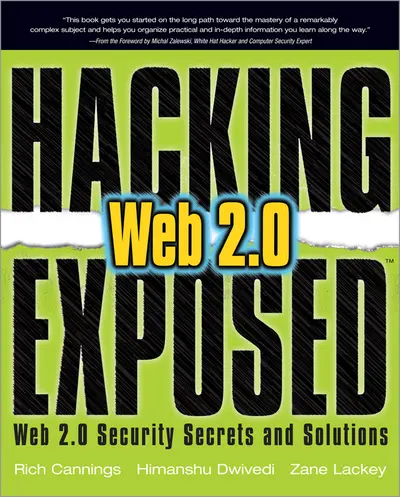My Account Details

ISBN10: 0071494618 | ISBN13: 9780071494618

Step 1 . Download Adobe Digital Editions to your PC or Mac desktop/laptop.
Step 2. Register and authorize your Adobe ID (optional). To access your eBook on multiple devices, first create an Adobe ID at account.adobe.com. Then, open Adobe Digital Editions, go to the Help menu, and select "Authorize Computer" to link your Adobe ID.
Step 3. Open Your eBook. Use Adobe Digital Editions to open the file. If the eBook doesn’t open, contact customer service for assistance.
Publisher's Note: Products purchased from Third Party sellers are not guaranteed by the publisher for quality, authenticity, or access to any online entitlements included with the product. Lock down next-generation Web services "This book concisely identifies the types of attacks which are faced daily by Web 2.0 sites, and the authors give solid, practical advice on how to identify and mitigate these threats." --Max Kelly, CISSP, CIPP, CFCE, Senior Director of Security, Facebook Protect your Web 2.0 architecture against the latest wave of cybercrime using expert tactics from Internet security professionals. Hacking Exposed Web 2.0 shows how hackers perform reconnaissance, choose their entry point, and attack Web 2.0-based services, and reveals detailed countermeasures and defense techniques. You'll learn how to avoid injection and buffer overflow attacks, fix browser and plug-in flaws, and secure AJAX, Flash, and XML-driven applications. Real-world case studies illustrate social networking site weaknesses, cross-site attack methods, migration vulnerabilities, and IE7 shortcomings. Plug security holes in Web 2.0 implementations the proven Hacking Exposed way Learn how hackers target and abuse vulnerable Web 2.0 applications, browsers, plug-ins, online databases, user inputs, and HTML forms Prevent Web 2.0-based SQL, XPath, XQuery, LDAP, and command injection attacks Circumvent XXE, directory traversal, and buffer overflow exploits Learn XSS and Cross-Site Request Forgery methods attackers use to bypass browser security controls Fix vulnerabilities in Outlook Express and Acrobat Reader add-ons Use input validators and XML classes to reinforce ASP and .NET security Eliminate unintentional exposures in ASP.NET AJAX (Atlas), Direct Web Remoting, Sajax, and GWT Web applications Mitigate ActiveX security exposures using SiteLock, code signing, and secure controls Find and fix Adobe Flash vulnerabilities and DNS rebinding attacks
Acknowledgments
Introduction
Part I: Attacking Web 2.0
Chapter 1. Common Injection Attacks
Chapter 2. Cross-Site Scripting
Part II: Next Generation Web Application Attacks
Chapter 3. Cross-Domain Attacks
Chapter 4. Malicious JavaScript and AJAX
Chapter 5. .Net Security
Part III: AJAX
Chapter 6. AJAX Types, Discovery, and Parameter Manipulation
Chapter 7. AJAX Framework Exposures
Part IV: Thick Clients
Chapter 8. ActiveX Security
Chapter 9. Attacking Flash Applications
Index
Need support? We're here to help - Get real-world support and resources every step of the way.